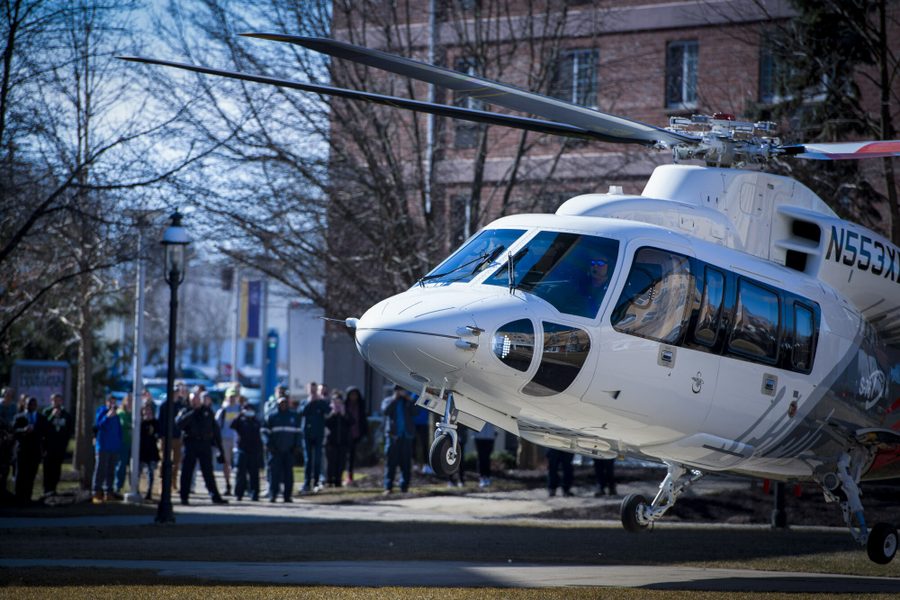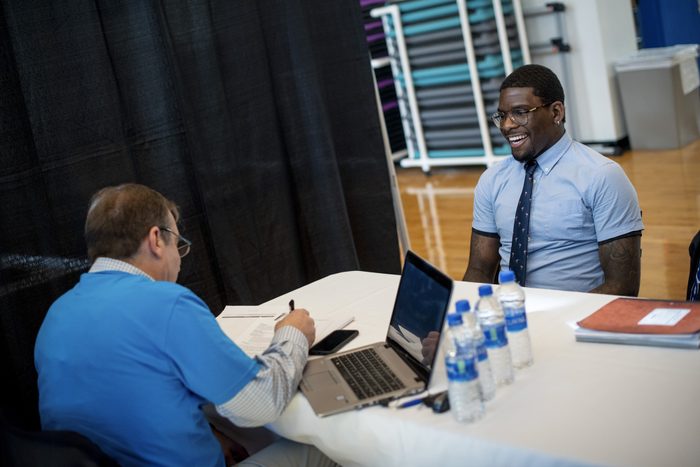Inside Lockheed Martin’s Sweeping Recruitment on College Campuses
The engineering degree to defense industry pipeline.
Indigo Olivier

A Sikorsky S-76 helicopter lands in the quad at the University of New Haven's Lockheed Martin Day 2020, which included a $100,000 donation for a Lockheed-sponsored mentorship program. COURTESY OF THE UNIVERSITY OF NEW HAVEN; PHOTOGRAPHED BY DEFINING STUDIOS & DEFINING PROPERTIES
To a casual observer, the Black Hawk and Sikorsky S-76 helicopters may have seemed incongruous landing next to the student union on the University of Connecticut’s pastoral green campus, but this particular Thursday in September 2018 was Lockheed Martin Day, and the aircraft were the main attraction.
A small group of students stood nearby, signs in hand, protesting Lockheed’s presence and informing others about a recent massacre.
Weeks earlier, 40 children had been killed when a Saudi-led coalition air strike dropped a 500-pound bomb on a school bus in northern Yemen. A CNN investigation found that Lockheed — the world’s largest weapons manufacturer — had sold the precision-guided munition to Saudi Arabia a year prior in a $110 billion arms deal brokered under former President Donald Trump.
Back in Storrs, Conn., Lockheed, which has a longstanding partnership with UConn, appeared on campus to recruit with TED-style talks, flight simulations, technology demos and on-the-spot interviews. A few lucky students took a helicopter flight around campus.
UConn is among at least a dozen universities that participate in Lockheed Martin Day, part of a sweeping national effort to establish defense industry recruitment pipelines in college STEM (science, technology, engineering, and mathematics) programs. Dozens of campuses nationwide now have corporate partnerships with Lockheed and other weapons manufacturers.
Lockheed is the country’s single largest government contractor, producing Black Hawks, F-35 fighter jets, Javelin anti-tank systems and the Hellfire missiles found on Predator drones. With more than 114,000 employees, the company depends on a pool of highly skilled and highly specialized workers, complete with the ability to obtain proper security clearances when needed. In its most recent annual report, Lockheed tells investors, “We increasingly compete with commercial technology companies outside of the aerospace and defense industry for qualified technical, cyber and scientific positions as the number of qualified domestic engineers is decreasing and the number of cyber professionals is not keeping up with demand.”
Lockheed has hired more than 21,000 new employees since 2020 to replace retiring workers and keep up with turnover. Student pipelines are integral to the company’s talent acquisition strategy.
As tuition costs and student debt have skyrocketed, Lockheed has enticed students with scholarships, well paid internships and a student loan repayment program. When the pandemic made in-person recruitment more difficult, Lockheed expanded its virtual outreach — after one 2020 virtual hiring event, the company reported a 300% increase in offers and a 400% increase in job acceptances among the STEM scholarship program participants over the previous year.
And in a self-described effort to diversify its workforce and build an inclusive culture, Lockheed has also put new focus on financial support and recruitment at historically Black colleges and universities.
Lockheed’s recruitment efforts are intertwined with various types of “research partnerships.” Universities receive six- and seven-figure grants from Lockheed and other defense contractors — or even more massive sums from the Department of Defense — to work on basic and applied research, up to and including designs, prototypes and testing of weapons technology. A student might work on Lockheed-sponsored research as part of their course load, then intern over the summer at Lockheed, be officially recruited by Lockheed upon graduation and start working there immediately, with defense clearances already in place — sometimes continuing the same work. In 2020, Lockheed reported that more than 60% of graduating interns became full-time employees.
(DESIGN BY DAVID FOSTER/RACHEL K. DOOLEY)
Lockheed is not alone among corporations or military contractors in its aggressive university outreach, but the expansive presence of private defense companies on campuses raises questions about the extent to which corporations — particularly those profiting from war — should influence student career trajectories. In April, student and community protesters at Tufts University shut down a General Dynamics recruiting event, then protested outside a Raytheon presentation later that month, chanting, “We see through your smoke and mirrors. You can’t have our engineers.”
Illah Nourbakhsh, an ethics professor at Carnegie Mellon University with a background in robotics, presents the question this way: “If you have a palette of possible futures for students, and you take some possible future, and you make it so shiny and exciting and amazing by pouring money on the marketing process of it that it overcomes any possible marketing done by alternatives that are more socially minded — do the kids have agency? Is it a fair, balanced field?
“Of course not.”
Lockheed did not respond by deadline to requests for comment on this article.
For more than a year, In These Times investigated the presence of Lockheed and other arms manufacturers on campuses, combing through company and university annual reports, IRS filings, LinkedIn profiles, budgets, legislative records and academic policies, as well as interviewing students and professors. Most students requested pseudonyms, indicated with asterisks*, so as not to adversely impact their career prospects. Several spoke positively of Lockheed.
“It’s probably what most engineers, especially in mechanical and aerospace who want to go into defense prospects, aspire to,” says Sam*, who graduated with a bachelor’s in aerospace engineering in December 2021. “They’re one of the biggest defense contractors in this country, so you have the opportunity to work on very state-of-the-art technology.”
Other students believe putting their skills to military use is unethical.
Alan*, a December 2021 graduate in electrical engineering at the University of West Florida who is currently job-hunting while living with his parents, says he’s not looking at defense contractors and is instead holding out for a position that allows him to leave the Earth better than he found it. “When it comes to engineering, we do have a responsibility,” he says. “Every tool can be a weapon. … I don’t really feel like I need to be putting my gifts to make more bombs.”
Located near the world’s largest Air Force base in the Florida panhandle, the University of West Florida regularly hosts recruiters from the defense industry, including Lockheed. Alan says companies like Lockheed set up tables in student buildings to recruit in the hallways.
“I just walked past those tables,” he says, “but sometimes they’ll call you over. It’s kind of like going to the mall, and people want you to try their soap. It’s kind of annoying, but I get that they always need new people.”
Our investigation found this unfettered recruiting access to be part of a deeper and growing enmeshment between universities and the defense industry.
Decades of state disinvestment in public higher education have converged with a growing emphasis on sponsored research, and in an era of ballooning student debt, the billions in annual defense spending prop up university budgets and subsidize student educations. The result is that many college STEM programs around the country have become pipelines for weapons contractors.

BIG NAME ON CAMPUS
The Georgia Institute of Technology’s campus in Midtown Atlanta features 400 acres of manicured lawns, sports facilities and collegiate Gothic-style red brick buildings, interspersed with an eclectic mix of facilities that chronicle the university’s evolution over 13 decades.
Romanesque, neoclassical and Renaissance revival facades clash with the concrete, Brutalist design of the architecture school and the jutting steel-and-glass exteriors and green roof of the LEED-certified Clough Commons. Portions of the 1996 Olympic Village have been converted into student housing. Academic buildings are connected by glass skywalks.
The barracks erected during World War II have been taken down, and the athletic fields no longer double as gunnery practice. Military training, once required for freshmen and sophomores, has been discontinued.
But if you’re an engineering student at Georgia Tech, Lockheed is omnipresent.
You may run into Lockheed’s recruiters at career fairs or in the lobbies of the Student Success Center, the School of Electrical and Computer Engineering or the College of Computing.
They may be hosting a seminar on space exploration in the Clary Theatre.
They may be sponsoring challenges and awarding prizes to students during “Engineering Week” or hosting workshops where teams use Minecraft and Lego bricks to explore the future of digital work.
You’ll see Lockheed’s logo displayed on the career center’s website and job portal alongside such other corporations as ExxonMobil, Capital One and The Home Depot — just one of Lockheed’s privileges as a member of the university’s Corporate Partnership Program.
As an Executive Partner, Lockheed is provided with interview rooms, consultations with the school’s employer relations team, and access to an online résumé book featuring current students and recent graduates. Georgia Tech also assists students with a Lockheed cover letter template.
And, of course, there’s Lockheed Martin Day.
“They show off some flight simulations but also you might give a recruiter your résumé and they might give you an interview,” says Sam, who was set to do an internship at Georgia Tech’s satellite laboratory on the grounds of Lockheed’s Marietta, Ga., aircraft plant before Covid shifted the internship remote. “I definitely aspire to get into Lockheed someday.”
Sam’s been set on the defense field since high school, inspired, in part, by watching documentaries about Area 51, the classified Air Force facility in Nevada at the center of UFO conspiracy theories, which was used to test Lockheed’s U-2 reconnaissance aircraft during the Cold War.
The opportunity to work on secret, cutting-edge technology attracts him to the company.
Other students aren’t as enthused about Lockheed’s campus presence.
Cameron Davis, who graduated from Georgia Tech with a bachelor’s in computer engineering in 2021, says, “A lot of people that I talk to aren’t 100% comfortable working on defense contracts, working on things that are basically going to kill people.” But, he adds, the lucrative pay of defense contractors “drives a lot of your moral disagreements with defense away.”
In 2019 and 2021, Lockheed was the university’s largest alumni employer, and the company has been one of Georgia Tech’s most frequent job interviewers since at least 2002.
“Even in my field — which isn’t even as defense-adjacent as aerospace engineering or mechanical engineering — companies like Raytheon will have dedicated programs to recruit people,” says Davis. “I’ve been in line with other companies at a career fair and defense contractors literally walk up to me in line and be like, ‘Hey, do you want to talk about helicopters or something?’”
“The corporate presence at Georgia Tech is a little bit overwhelming at times,” says Adam*, a graduate student in machine learning. “The college very aggressively pushes getting a career, which is great for a lot of people, but sometimes I feel like there’s not enough emphasis placed on taking into consideration the moral and ethical side of it.”
As alternatives to employment with defense contractors, STEM students could be working on technologies to decarbonize the power grid, revolutionize transportation or reimagine the built environment. Upon graduation, they could take jobs at the Federal Aviation Administration, EPA or NASA.
“I talk a lot about opportunity costs,” says Nourbakhsh, who teaches a freshman ethics class at Carnegie Mellon. “It doesn’t matter whether somebody else will do that work or not. What matters is what you want to be proud of doing in your life. If you choose to do thing A and work on this military project, then you’re explicitly choosing not to do things B, C, D and E.”


THE MILITARY’S STUDENT RESEARCHERS
Clifford Conner recalls his freshman year at Georgia Tech, in 1959, when the school was still segregated. He studied experimental psychology. When graduation approached, his professors — who also worked in the Lockheed Corporation’s Marietta office just north of Atlanta — said they could help him get a job at Lockheed. Conner accepted.
His work on the wing design of the C-5 Galaxy, then the largest military cargo plane in the world, took him to England, where he began reading a lot about the war in Vietnam. “I wasn’t under the spell of the American press,” Conner says. After a few years with Lockheed, he quit and joined the antiwar movement.
It took him another year to find a job at about a third of the salary he was making at Lockheed.
Conner went on to become a historian of science and a professor at the CUNY School of Professional Studies. His most recent book, The Tragedy of American Science: From Truman to Trump (2020), explores how the STEM fields have moved away from improving the human condition to advancing corporate and defense interests. He writes about the Bayh-Dole Act, which removed public-licensing restrictions in 1980 and “opened the floodgates to corporate investors seeking monopoly ownership of innovative technology.” The law allowed universities and nonprofits to file patents on projects funded with federal money, from weapons to pharmaceuticals. The rationale was to encourage commercial collaboration and underscore the idea that federally funded inventions should be used to support a free-market system.
“After the Bayh-Dole Act, the lines between corporate, university and government research were all blurred,” Conner tells In These Times.
Then, in the 1990s, President Bill Clinton’s administration hatched the idea of giving large federal research grants to universities with a partner company built in, explains Peter Asaro, a philosopher of science, technology and media and an associate professor at the New School.
“The idea is, you get basic research or proof of concepts of technological innovations to come out of the university system, and then you transition that to a defense contractor who is going to develop it to the point where it becomes something that the military can actually use,” Asaro says. “Starting around 2000, [the government] really targeted specific institutions with strong engineering programs with partnership models. A big part of that initiative in the early 2000s was to establish research collaborations between universities and defense contractors.”
Lockheed’s relationship with Georgia Tech has only strengthened since Conner’s time as a student.
Georgia Tech’s applied research division, known as the Georgia Tech Research Institute (GTRI), now has four laboratories directly on Lockheed’s aeronautics campus in Marietta, after borrowing an estimated $62 million in 2017 to purchase the facilities from Lockheed and renovate them. The sprawling new facility, dubbed the Cobb County Research Facility South (CCRF-South), is located on an old Air Force plant adjacent to the Dobbins Air Reserve Base, which shares a runway with Lockheed. Next door, Lockheed assembles C-130 military transport planes and the center wing of the F-35 fighter jet.
As a financially independent lab affiliated with Georgia Tech, GTRI relies on sponsored funding for its research.
In 2021, GTRI received more than $780 million in sponsorships, which exceeds the university’s combined revenue from tuition and state appropriations. Ninety percent of GTRI’s funding comes from the Pentagon.
CCRF-South features more than 200,000 square feet of offices, laboratories, an auditorium, a communal dining area and bright co-working spaces. An additional 140,000 square feet of high-bay industrial warehouse space is dedicated to individual assembly labs equipped with cranes capable of lifting up to 30 tons. Inside the laboratories, researchers and students work on everything from missiles, sensors and radar to target identification, drone testing and weapons systems simulations.
Details of weapons research can take years to obtain through public records requests, if at all, because they are deemed proprietary or classified. Students at Georgia Tech were reluctant to speak with the press about the details of their defense work. An unspecified number are required to sign non-disclosure agreements and obtain security clearances.
But publicly available CVs, résumés and job listings for student researchers at GTRI explicitly detail work on weapons technology.
Additionally, GTRI’s annual reports show that the labs have worked on simulators for Lockheed’s Black Hawk helicopters and flight data analysis for the F-35 fighter jet. It also has an office at the Army’s Aviation & Missile Center and an “indefinite delivery, indefinite quantity” research contract with the army, potentially worth $2.35 billion over 10 years. GTRI provides technical support and prototyping to the Distributed Common Ground System, the Pentagon’s 24/7, global, near-real-time intelligence and combat network that analyzes data from Global Hawk, Predator and Reaper drones.
Since 2012, GTRI has more than doubled its revenue, and CCRF-South is set up to accommodate its expansion.
“There are graduate students who are dependent on those [defense grants],” says Asaro. “That’s the pipeline because basically you’re paying for the degree, you’re paying the room and board, their salaries while they’re getting the degree, and then they’ve become an expert in the system that is going to transition to this private contractor who’s standing there with a job waiting for this graduate student to finish this degree.”
Georgia Tech did not respond by deadline to requests for comment on this article.
Nourbakhsh, at Carnegie Mellon, does not take military funding for research at his Community Robotics, Education and Technology Empowerment Lab. Today, he says, it’s not unusual for professors to refuse defense funding in their labs.
He believes seeing professors “do the right thing” can have a great influence in the STEM field. But he also says universities have become fundamentally reliant on defense funding.
“If 50 other professors in my department did it [refused military funding], there just wouldn’t be enough money,” says Nourbakhsh. “The research direction here gets set by the industrial, military-industrial, and government complexes, rather than by individual professors.”
Unlike Europe, the United States does not provide universities with general funding to support basic research, or “research for the sake of research.” A 2019 analysis by the American Association for the Advancement of Science, for example, notes, “on average, one-third of R&D in OECD countries” is funded by “government block grants used at the discretion of higher education institutions” — but the United States does not have the same mechanism.
U.S. appropriations to public higher education, meanwhile, have declined significantly in the past two decades, while the research environment has seen universities performing an ever-larger share of the nation’s technology research. The Defense Department has been the third-largest source of federal research and development funding to universities for decades (after the Department of Health and Human Services and the National Science Foundation).
But universities also seek out private-sector money to fund research directly, and the defense sector has been a willing donor.
In recent years, Lockheed has partnered with a network of more than 100 universities to advance hypersonics technology — weapons traveling so fast they’re undetectable by radar — and signed master research agreements for multi-year collaborations with Purdue, Texas A&M and Notre Dame in 2021.
While delivering technological innovations to defense companies, these partnerships also double as employment pipelines. The University of Colorado Boulder has collaborated on space systems with Lockheed for nearly two decades. In a statement on the university’s website, one Lockheed executive (and school alum) writes, “Lockheed Martin employs about 56,000 engineers and technicians, 35% of which could retire in the next few years. We must keep up a ‘talent pipeline’ to fill this pending gap: currently, our major source of talent is CU-Boulder.”

SADDLED WITH DEBT
Nearly half of the nation’s discretionary budget goes toward military spending; of that money, one-third to one-half goes to private contractors, according to a 2021 analysis by military researcher William Hartung for Brown University’s Costs of War Project.
Today, 46 million Americans hold student debt totaling $1.7 trillion, which is the projected lifetime cost to U.S. taxpayers of Lockheed’s F-35 fighter jet program — the most expensive weapon system ever built.
One featured employee on Lockheed’s website, Luis, says he’s worked as a circuit design engineer at Lockheed for five years. Before starting at Lockheed, he racked up $187,000 in student debt.
“As a first-generation immigrant college student, my parents did not have the wisdom to provide me with the proper guidance,” he says on the Lockheed website, referring to the college application process.
After earning a master’s in electrical engineering, Luis got a job with Lockheed, where he took advantage of the company’s tuition reimbursement program to earn a second master’s in computer engineering. “This was accomplished while paying off both my wife’s and my student loan debt totaling over $337K,” Luis says. “After five years, we are now DEBT FREE!”
Lockheed is among a growing number of companies that offer student loan assistance to its employees. The company’s Invest In Me program offers incoming graduates a $150 monthly cash bonus for five years and a student loan refinancing program. Every year, Lockheed awards $10,000 scholarships to 200 students that may be renewed up to three times for a potential $40,000. Lockheed also lists 61 universities participating in its STEM scholarship program, projected to invest a minimum of $30 million over five years as part of a larger $460 million education and innovation initiative using gains from Trump’s 2017 corporate tax cuts.
In a 2015 survey by American Student Assistance, 53% of respondents said student debt was either a “deciding factor” or had a “considerable impact” on their career choice.
“Pushing people into higher education has been our labor policy,” explains Astra Taylor, a writer, filmmaker and co-founder of the Debt Collective, a debtors’ union with roots in Occupy Wall Street. “You’re indebting yourself for the privilege of being hired, and it gives companies this economic power because then they can say, ‘We can help relieve some of the economic pain that you’ve incurred to make yourself appealing to us.’”
Raytheon, Northrop Grumman and Boeing all provide some form of student aid, such as scholarships and tuition reimbursement.

DIVERSIFYING WEAPONS MAKING
The private defense sector targets much of its financial support toward historically Black colleges and universities (HBCUs) and students from minority groups as part of stated efforts toward workforce diversity and promoting STEM jobs among a demographic that is critically underrepresented in STEM fields. Lockheed’s website and annual report note that minority groups are the “fastest-growing segment in the labor market” and that recruitment through “internships, early talent identification, outlying educational programs, co-ops, apprenticeships and pre-apprenticeships” is integral to building diverse employee pipelines.
This trend stirs up old controversies around military recruiting in communities of color. The Army has long targeted minority-majority high schools and HBCUs with its Reserve Officers’ Training Corps programs and scholarships, to the extent that critics refer to it as a school-to-soldier pipeline. Without enlisting and the ensuing funding, many students wouldn’t receive a higher education. According to a 2016 report from the Brookings Institution, Black students hold an average of $7,400 more in student debt than their white counterparts upon graduating — a gap that widens to nearly $25,000 four years later. The Army leverages students’ predicaments to meet its recruiting goals.
Regardless, “the racial implications” of U.S. military actions “are hard to evade,” civil rights activist and Rep. John R. Conyers Jr. (D-Mich.) said at the outset of the Iraq War in 2003. “Would this be happening to [the Iraqis] if they were not nonwhite?” A Gallup poll at the time found 7 in 10 Black Americans opposed the war, while 8 in 10 white Americans favored it.
Joshua Myers, an associate professor of Africana studies at Howard University, an HBCU, and author of We Are Worth Fighting For: A History of the Howard University Student Protest of 1989, notes the history of resistance to military recruiting at HBCUs. “Howard students shut down the university in 1925 over mandatory ROTC,” he says.
Today, ROTC’s offers to HBCU students of a debt free education are mirrored by offers from the defense industry.
Lockheed has started STEM education and recruiting initiatives at 20 minority serving institutions (MSIs), including 16 HBCUs. Of Lockheed’s 2021 scholarship recipients, 60% identified with a minority racial or ethnic group. In the 2020 to 2021 academic year, more than 40% of Lockheed’s early-career hires identified as people of color, with 450 coming from MSIs.
“Students who work in these spaces don’t know the gravity — are systematically made ignorant of the gravity — of participating in these systems,” says Myers.
The defense industry fills funding gaps for HBCUs, which have endowments averaging 70% less than their non-HBCU counterparts. Howard has a formal partnership with Lockheed, which sponsors the business school’s Cybersecurity Education & Research Center and is listed in the Trustees’ Circle of donors. In 2020, Lockheed was named the top industry supporter of HBCU engineering institutions for the seventh consecutive year by U.S. Black Engineer and Information Technology Magazine.
Howard also hosts one of the country’s 25 chapters of Dissenters, a youth-led antiwar group that launched in January 2020 with the ambitious goal of defunding the military.
In February 2020, Howard’s chapter posted a video of organizers passing out flyers and raising awareness about Lockheed outside of the College of Engineering as company representatives recruited students in the lobby.
“You said that the CEO was an advocate for women and minorities,” a student organizer says during a recruitment presentation. “How does she maintain that role as head of a company that produces weapons which bomb and kill women and children in places like Palestine, Yemen, Libya and the Middle East?”
The recruiter responds: “I have no idea.”
MONEY TALKS
Ultimately, Lockheed’s deep reach into higher education reflects national priorities.
Since 9/11, the United States has spent $8 trillion on war. In 2020, for the first time, federal funding to Lockheed surpassed that of the U.S. Department of Education, the federal agency tasked with dispensing scholarships and Pell grants. Biden requested $813 billion in defense spending for fiscal year 2023, which includes the largest-ever allocation for research and development.
“Of course it’s the defense industries that have the ability to offer these favorable terms to people, because they’re also parasites on the public purse,” Astra Taylor says. “If these students weren’t worried about the cost of college, would they be as apt to take a job at a defense contractor versus doing something else in their community?”
Conner doesn’t fault students for taking jobs in the defense industry. “[They] realize that if they’re going to get a job when they graduate, it’s going to be at one of these places. And they can protest all they want, but they’ve got to be the spearpoint of a larger protest that involves the whole society.”
Maggie Duffy, Eloise Goldsmith and Jack McCordick contributed fact-checking.
This reporting was supported by the Leonard C. Goodman Institute for Investigative Reporting.
This reporting is ongoing. If you are open to sharing your experiences of research, recruitment or employment by Lockheed or another U.S. military contractor, we want to hear from you. You can reach out to the author at indigoolivier [at] gmail [dot] com or via encrypted protonmail at indigoolivier [at] protonmail [dot] com.
Indigo Olivier is a reporter-researcher for The New Republic and a 2020-2021 Leonard C. Goodman investigative reporting fellow. Her writing on politics, labor and higher education has appeared in the Guardian, The Nation and Jacobin, among other outlets.









